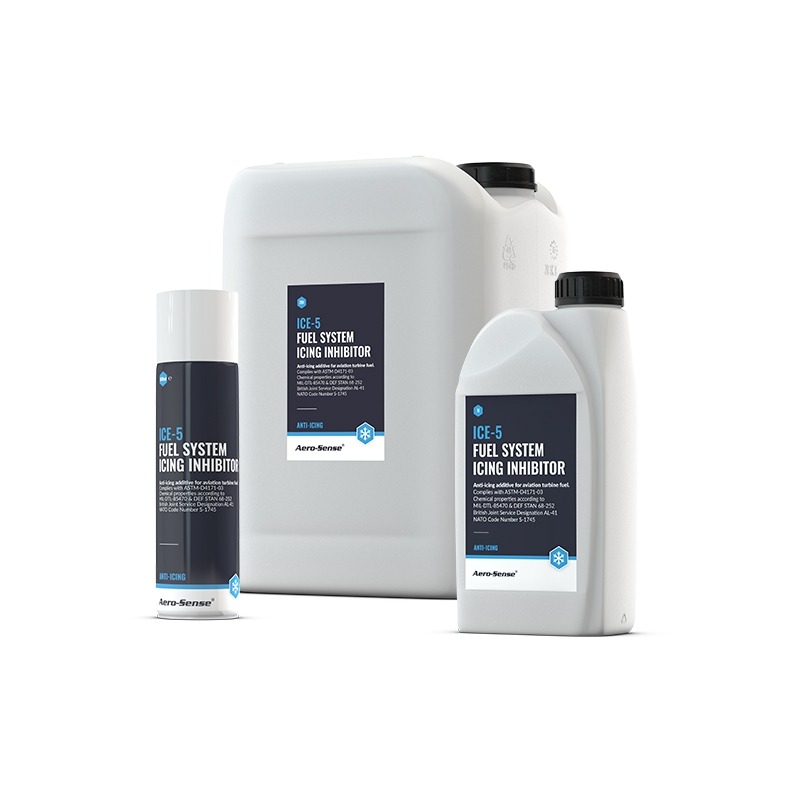A clear guide to using ICE‑5 Fuel System Icing Inhibitor (FSII)
Ensure your kerosene is safe and ice‑free
Temas de este artículo
What is a Fuel System Icing Inhibitor (FSII)?
ICE‑5 is Aero-Sense’s certified FSII product. Fuel System Icing Inhibitors (FSII) are additives used in jet fuels to prevent the formation of ice in fuel systems. They absorb free water present in the fuel and keep it in solution, avoiding the risk of ice blocking fuel lines, filters, or valves during flight.
Why proper mixing of FSII matters
- ICE‑5 must be mixed thoroughly with the fuel to be effective.
- If not mixed, it settles to the bottom and doesn’t remove water.
- Water in jet fuel can freeze at altitude, leading to blockages in fuel lines or filters — a serious safety hazard.

Two methods to apply Fuel System Icing Inhibitor
Method A – Using the aerosol directly in the fuel stream
Best for ensuring thorough mixing during refuelling:
- Calculate the required amount of ICE‑5. (See below for an example how to do this)
- Wear proper safety equipment.
- Open the aerosol.
- Take out the tube with galvanised clip.
- Attach the clip to the fuel nozzle.
- Fix the actuator tube to the aerosol.
- Start refuelling and simultaneously activate the aerosol.
- (Optional) Use a can gun for better control.
Fuel flow ensures immediate mixing and contact with water particles.
Method B – Using the 1L bottle in a mixing tank
Ideal when you have an external recirculation tank:
- Calculate the required amount of ICE‑5. (See below for an example how to do this)
- Wear safety equipment.
- Open the bottle.
- Pour ICE‑5 into the external tank with mixing capability.
- Ensure active mixing or recirculation.
- Fuel the aircraft from the mixed tank.
⚠️ Do not pour ICE‑5 directly into the aircraft fuel tank without mixing — it will sink and separate without removing water.
Why we recommend the aerosol format
We strongly advise using the aerosol format. It ensures ICE‑5 is added directly into the fuel stream — guaranteeing mixing and effective water bonding.
To support this, we are offering a discount on ICE‑5 aerosols. With our new warehouse capacity, we hold more raw materials and benefit from economies of scale, allowing us to lower prices across the board.
We strongly advise using the aerosol format. It ensures ICE‑5 is added directly into the fuel stream — guaranteeing mixing and effective water bonding.
How to calculate the correct amount of ICE‑5 Fuel System Icing Inhibitor
ICE‑5 must be added at specific concentrations, depending on your fuel specification.
Dosage guidelines:
- MIL‑DTL‑83133: 0.07% – 0.10% by volume
- DEF STAN 91‑91: 0.10% – 0.15% by volume
Calculation example for 1000L of fuel
Conform MIL‑DTL‑83133:
- Minimum: 0.7 L ICE‑5 (1,000 × 0.07%)
- Maximum: 1.0 L ICE‑5 (1,000 × 0.10%)
So, add between 0.7 and 1 litre of ICE‑5 for every 1,000 litres of fuel to meet MIL‑DTL‑83133.
Conform DEF STAN 91‑91:
- Minimum: 1.0 L ICE‑5 (1,000 × 0.10%)
- Maximum: 1.5 L ICE‑5 (1,000 × 0.15%)
So, add between 1 and 1.5 litres of ICE‑5 for every 1,000 litres of fuel to meet DEF STAN 91‑91.
Pre‑flight check: drain until you see clean fuel
Before each flight, it’s essential to drain a fuel sample from the aircraft’s tank — typically from the low‑point drain under the wing. This is a standard safety step, and it’s especially important when using ICE‑5.
Here’s how to do it correctly:
- Use a transparent container to collect the drained fuel (e.g. clear sampling cup).
- Open the drain and allow the first portion of fuel to flow out.
- Continue draining until you observe a clear separation line — between heavier liquid at the bottom (where water and possibly ICE‑5 settle) and the upper layer of pure kerosene.
- Once only clean, single-phase kerosene is coming out — with no more separation — you can stop. The tank is now considered free of drainable water.
🧊 ICE‑5 bonds with water, but it does not mix with kerosene. After proper mixing, any bonded ICE‑5/water will settle to the bottom of the tank and be drained first.
⚠️ Important: You cannot visually confirm whether ICE‑5 has bonded with all the water. That’s why correct mixing during application is essential. If ICE‑5 was poured in without mixing, it may settle to the bottom without ever interacting with the water, leaving untreated fuel above.
Common pitfalls to avoid
❌ No mixing = no protection.
❌ Wrong dose = under- or overdosing.
❌ No pre-flight check = risk of untreated water.
❌ Pouring bottle directly into tank = separation, no bonding.
❌ Contact with painted surfaces = potential damage (avoid contact with ICE‑5).
Conclusion
ICE‑5 is a critical safety additive that prevents fuel system icing. But it must be used correctly — calculated, mixed, and verified. The aerosol method offers the most user-friendly and reliable solution. Take advantage of our promotional pricing, and ensure your aircraft is protected from fuel icing.
If you need help calculating your dose or setting up your application process, feel free to contact us.
More information about ICE-5: https://www.aero-sense.com/en/ice-5-fuel-system-icing-inhibitor